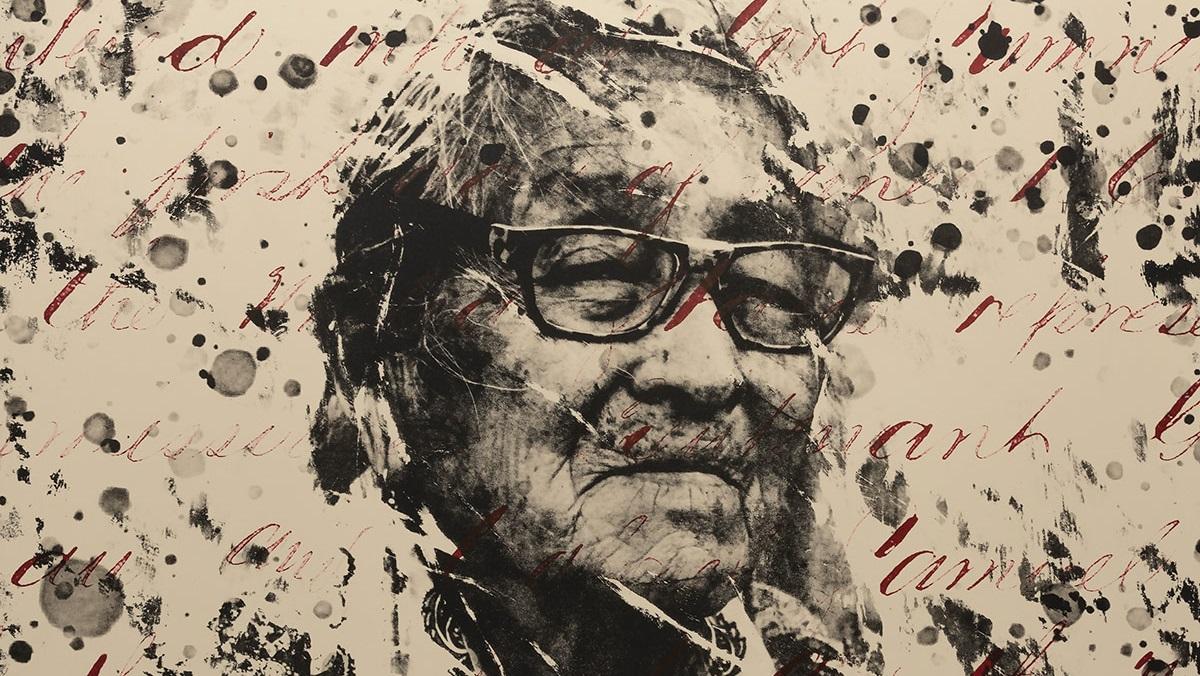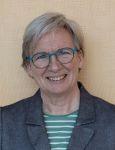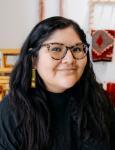Dakota Mace, as a Diné (Navajo) artist, focuses in her work on translating the language of Diné history and beliefs. She recently curated Reclaiming Identity, an exhibit of 25 Indigenous artists from across the U.S. and Mexico at the Trout Museum of Art in Appleton. In her own work, Mace draws from the history of her Diné heritage, exploring the themes of family lineage, community, and identity. Her work pushes the viewer’s understanding of Diné culture through the use of alternative photography techniques, weaving, beadwork, and papermaking. She talked recently about her creative process with Jody Clowes.
J: Tell me about the process of making this series. Helen Nez is actually a lithograph, right, as opposed to the chemigrams and cyanotypes you’ve been creating recently?
D: It’s kind of a combination of both. A lot of the photographic techniques that I use would be considered printmaking processes as well. Jumping back into printmaking has been a lot of fun. During my undergraduate work at the Institute for American Indian Arts in Santa Fe, I was focusing on printmaking and then slowly got into photography.
J: I didn’t realize that you started out as a printmaker. How do you decide what technique or material to work with for a particular piece?
D: So this work is part of a larger series, a larger body of work that I can’t talk about just yet. But the title of the series is Dahodiyinii, which translates to sacred places. The project is about retracing the stories and memories from my community and looking at the land and the way that it presents itself. So I used a combination of different mediums to look at the importance of land as a place of healing. Something that I wanted to come across with this project was the importance of the Diné story, and also how our close relationship to our home is an important aspect of who we are.
Something that comes up with this particular project is looking at how certain areas within our community have sacred significance, places of stories. We usually go to these places to connect to our ancestors and essentially just connect with the powers of the land. We never forget that we exist within a larger story, and are also part of a much larger living system that includes not only the water, but also the earth, the canyons, and the plants.
The entire project looks at the importance of natural materials, and at the Long Walk that my ancestors took in 1864. And this meant following the original route to Bosque Redondo, also known as Fort Sumner. I wanted to focus on certain elders and their stories. Telling the stories is an important part of this project, and also looking again at the relationship between land and community.
As a storyteller and also an image-maker, I wanted to use the printmaking process to activate the photographs and portraits of Helen herself, and to create textures that are similar to the landscape itself. Really emphasizing the power of nature, and also our ancestral memory, our indigenous knowledge.
So for Helen, this was important for me because not only is she Diné, but she is also related to me by my maternal clan, which is the Red House. Through our clan, we were able to connect and build this interesting connection with one another through my grandfather. And we were able to look at the Navajo Treaty of 1868, when my ancestors were released from Bosque Redondo, and find out what that treaty represented and how it created a significant shift in Diné history even today.
So the original title of the treaty is Naal Tsoos Saní, which translates to The Old Paper. And this is why I wanted to go back to printmaking and especially lithography, because of the process: the way that we’re able to create an image on top of the paper itself, but also layer it to signify the different moments in history.
It was at the signing of this treaty at Bosque Redondo that my ancestors essentially lost their freedom, their autonomy, and came under the rule of the U.S. government. So with each image, there is a series of five prints. And as you look at the prints, Helen slowly starts to fade away. And this is a reminder of how many of our elders’ stories disappear once they’re gone, especially the history that’s within their words.
For Helen, this treaty not only affected her past, but also the history of the land that she comes from. And for Helen, when she was a child, living close to the uranium mining companies, which used the Diné people to detect uranium deposits changed her perception of the U.S. government. She continues to persevere, even though she lost eight of her eleven children due to contamination from those mines.
J: That’s an overwhelming history.
D: But she still perseveres. She is a strong, powerful woman. And she is still one of the biggest activists against uranium mining.
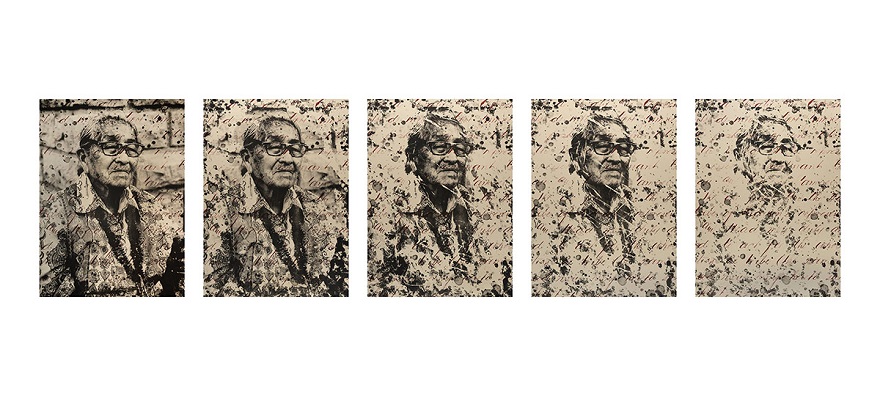
J: Had you met Helen before this project? Is she someone who was in your life, or is she someone you have gotten to know through her advocacy?
D: She is someone that I met with. Like I said, this project involved building connections with my clan, my family particularly, and looking at our origins and our family story.
J: Not knowing that story before our conversation, and just looking at the work itself, I think you’ve communicated the feeling of land and disappearance effectively. I think I understand how you’re working with that idea through the lithographic process. Can you describe how these prints are made, the way that you begin with one image and remove elements of it bit by bit?
D: The process is done in an unconventional way. I love to play around with the processes and really experiment. I worked with Derek Hibbs, who is also a Madison artist, and we were able to figure out what we wanted to create on the image and then slowly take away portions of the metal printing plate itself. So that meant actually destroying the plate, with the intention of looking at how, again, much like Diné history, a lot of things are lost and change drastically in the process. Also on the plate is the first page of the Navajo Treaty of 1868.
J: I see that. It’s ironic that the treaty script is such a beautiful element of the image. Let’s talk about your relationship to photography. You often describe yourself as a photographer but, as you’ve said, most of your work doesn’t really look like photography. Did you start out working more traditionally, or did you move right into these alternative photographic processes from the beginning?
D: I have always been fascinated by photography. Something that inspired me was a particular room in my grandma’s home that showcased everyone’s photographs, some of which were printed on copy paper or didn’t have any frames. Something about that wall always stuck with me as a child, being able to look at how we as a people preserve our visual history, our visual narratives within our homes.
So that was the initial point for me, looking at photography as a chance to change our narrative. At the Institute of American Indian Arts, I started with traditional black and white darkroom photography, but within my first year I started to learn different alternative processes. The reason behind that is that we went completely nontoxic at the Institute, and we had to get really creative with the way we created images.
So I started looking at these different processes, while taking printmaking courses at the same time and kind of combining both interests. And it was important for me to think about ‘what is a photograph,’ and what are the different ways to create one. But also, now that I’m working with textiles, a big part of my practice has become looking at ways that textiles and photography are similar in terms of the chemistry. There’s an opportunity to be creative and painterly in the way you interact with those materials.
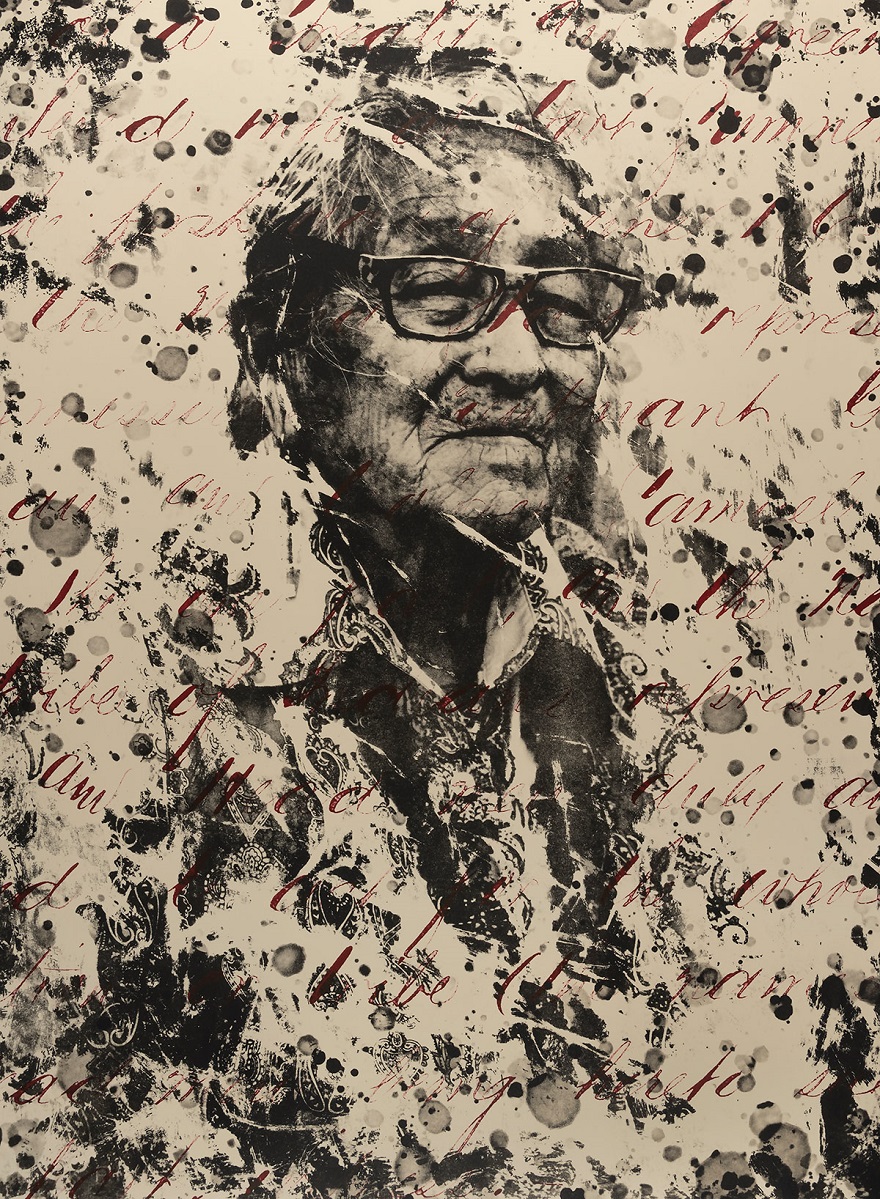
J: I haven’t thought about textiles and photography being related in that way. You’ve often worked with weaving, beadwork, and other textile media, and you sometimes refer to textile media in your photography. In these most recent pieces, are they moving away from that connection, or is there still something there for you that feels connected to textile tradition?
D: Definitely. We haven’t included a lot of my textile pieces in this show (James Watrous Gallery exhibition, Fall 2022) because they’re out for other exhibitions, but there is still a big emphasis in textiles within my work, and especially with a recent series that’s titled Dahodiyinii. These are cyanotypes that are actually dyed with cochineal.
Combining the photographic process and textile dyes is important for me. Through the process of creating these cyanotypes, I’m looking at American history and the way that the U.S. Army expelled our people from our ancestral homeland as an act of ethnic cleansing that became the Long Walk. The number of people who were lost during this walk was significant. It was 400 miles from Bosque Redondo, all the way back from their homes and everything, and the actual number of my ancestors that were lost was never recorded. So with these cyanotypes, the goal is to create a series of over 2000.
And each one has deep significance, because the cyanotype is a form of photography that doesn’t require a camera. I allow the paper and the print to interact with the environment. So placing it directly within the land at these different points of trajectory, following my ancestors’ path, the wind, the water, the sand, the plants, they all leave imprints. They leave traces in different ways on each of the prints.
Through this process, it’s important for me to be able to focus not only on the abstraction of these pieces, but also to honor each and every one of my ancestors who lost their lives during this forced migration. It is a special and important ceremony.
J: That’s beautiful. So by leaving this paper out in the landscape, you’re inviting these natural forces to interact with it. And your own hand is not involved in the image, you’re letting the land create it?
D: Yeah.
J: That’s amazing. So cochineal was a traditional dye for your people. Tell me about what that means to you and the significance of cochineal in particular.
D: As an artist, I have focused on spending at least four years with each of the colors that I work with. The colors are important in my work. So the last color that I did was indigo, really understanding the way the dye interacts with different types of materials, especially within a photograph, with textile pieces, with handmade paper. But with cochineal, it’s a completely different experience.
Looking at it from a historical perspective, the movement of cochineal pre-contact connected a lot of indigenous communities. I’ve been working with weavers based in Oaxaca to source the dye, seeing how their history is connected to cochineal and building relationships with them to process the material itself. It still comes in the form of dried insects and then you break that down further.
J: It sounds like your training at the Institute was primarily in printmaking and photography. Did you learn to work with textile media in school as well, or did you start working with textiles when you were younger?
D: I grew up seeing textile weaving and dying being done in my family. But most of the artists within my family have been silversmiths. So that’s something that has been a big aspect of my work, looking at how silversmithing has been a big part of our identity, and also how those designs are translated from the land itself.
Through my research for a recent piece called Shared Histories, I came to understand that my third great-grandmother was a big part of the textile tradition within our family and to see where that tradition came from. But textiles came into my life later on. It was something that I picked up quickly. My mom and my grandma would tell me all the time, “it’s in your genetics that you were able to pick up weaving so quickly.” It’s important to me to be carrying on that tradition.
J: Diné tradition and Diné art have been a constant thread for you. Is there an element of your work that speaks directly to other Diné, that would only be apparent to someone who’s conversant with your tradition and your culture?
D: Definitely. There are a lot of aspects of my work that are, you know, just for the people. Especially the current work that I’m creating—it’s for my community and for my people. It’s a big part of our culture, that we are individuals, but we make up this bigger identity all together.
And that’s also why I work in multiples. Each print is unique. They’re always different. It’s like how designs are translated differently by different weavers. So we have similar stories, and in the designs we use, we’re all connected to one another. And all of our stories together are our larger identity and culture, much like the stars are part of the larger universe.
Often people will say my work isn’t something they’d traditionally associate with a Native or Indigenous artist. It challenges their perception of what it means to be Indigenous, and what it means to create art that’s related to your culture. It’s important to teach audiences that not all Native art has to look a particular way, or be held in a static visual presentation. It’s ever-evolving. Much like indigenous people, it’s always changing. We’re always adapting and adding to our materials and our processes and our understanding of our work.
J: What would you like visitors to take away from your exhibition?
D: An appreciation of the stories that each of these pieces represents. I selected three series that have been a big part of my progress as an artist, but there’s also the significance of why I selected these. They’re about our relationship to memory and land, the stories of our ancestors, and of missing and murdered Indigenous women today. These stories are important. They’re still affecting Indigenous people today, and are often not understood by people outside of our communities. We’re fighting to preserve our land and of course, to preserve our memory.
Dakota Mace, Łichíí landscape series, chemigrams, 6 x 9 inches.
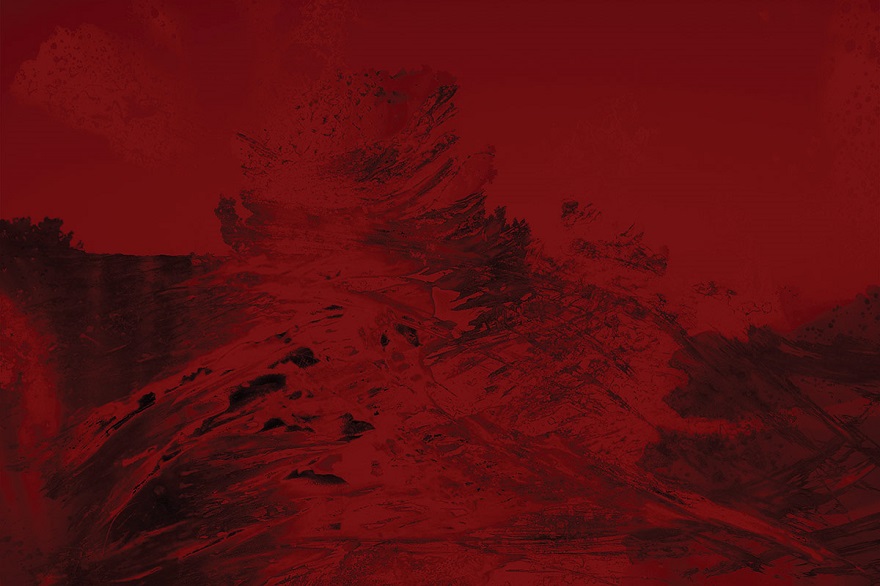
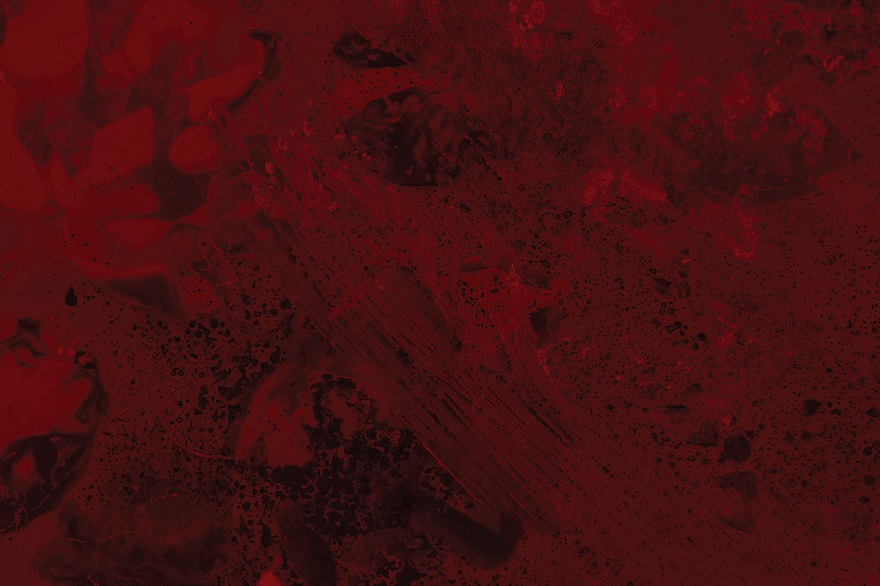
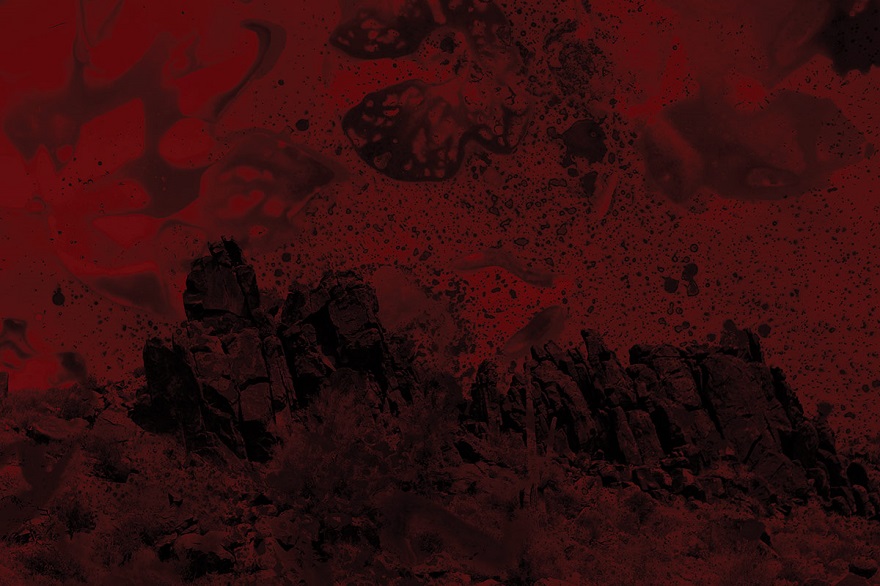

How are Dakota Mace’s Łichíí (Red) prints made?
They begin as cyanotypes, which are contact prints made by exposing paper coated with UV-reactive chemicals to sunlight. With cyanotypes, you don’t use a camera to capture an image of something. Instead you use the thing itself, capturing the silhouette of the object by placing it on the coated paper and exposing it to sunlight. The resulting print is a deep blue, like a blueprint.
The Łichíí (Red) prints are created in several discrete steps. Mace begins by placing paper coated with UV-reactive chemicals in the landscape, leaving them long enough for the action of wind, water, and earth to create images on the surface. Back in her studio, she scans these cyanotype prints and then dyes the scans with red cochineal. As the resulting artworks are primarily red rather than the blue associated with cyanotypes, Mace describes them as “chemigrams,” a general term which encompasses several similar camera-free photo-processes.
What is cochineal?
The cochineal, a tiny, cactus-dwelling insect that produces a vibrant red pigment, was harvested for thousands of years by Indigenous peoples in tropical and subtropical parts of the Americas to produce dye for their textiles.
Following the Spanish invasion of the Americas, cochineal ultimately became a globally traded commodity. In Europe, its red became the color of power, tinting the red coats of English soldiers and the Catholic clergy’s capes. Its commerce transformed the world of textiles, art, and trade, but at the expense of the Indigenous knowledge systems and labor that brought it to bear in the first place.

